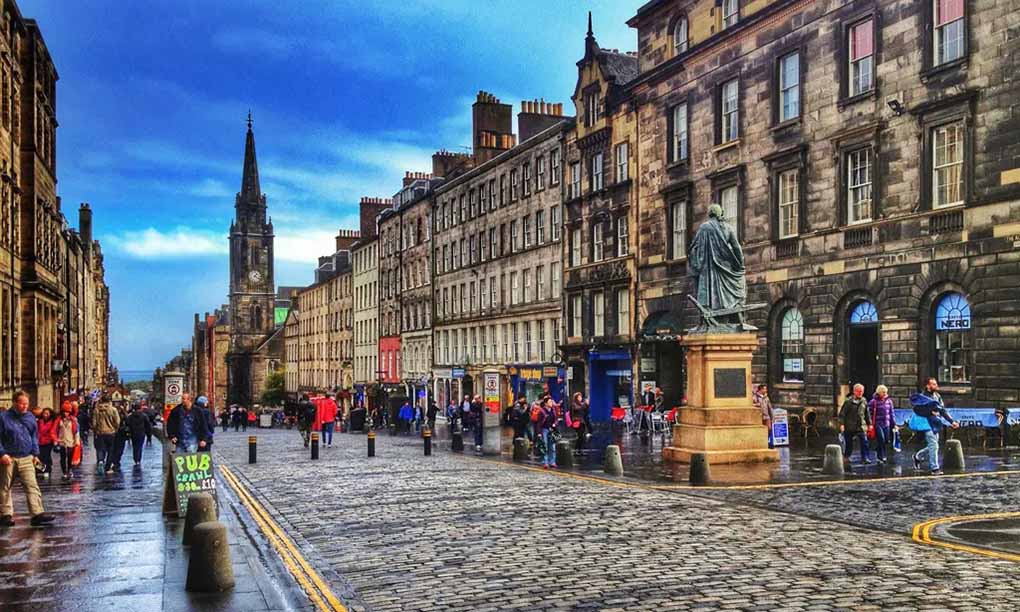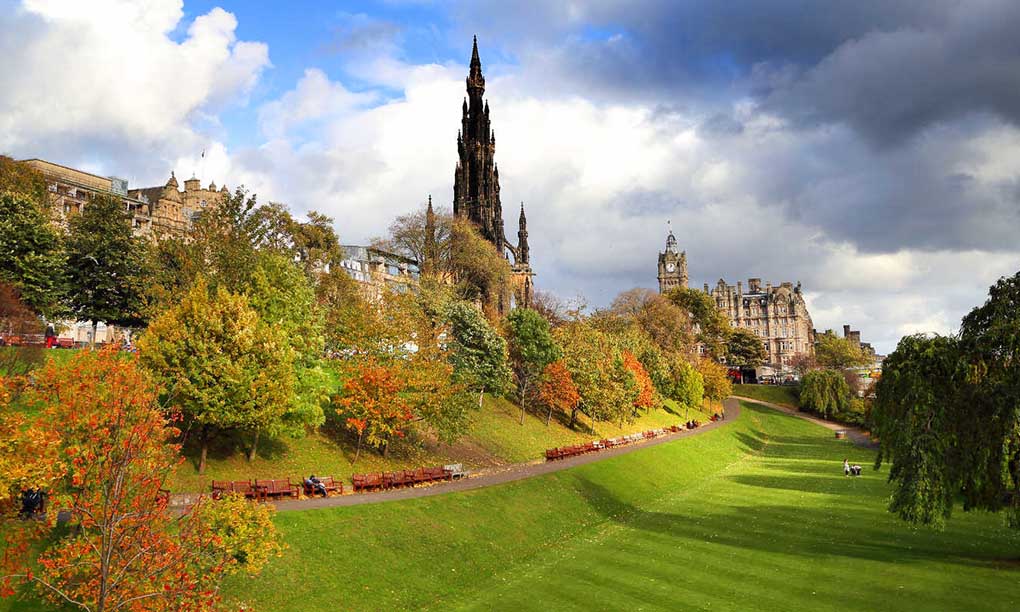Edinburgh, a city with a history spanning over a thousand years, is one of the cultural and political hubs of Scotland. It is not only the birthplace of traditional foods like whisky and haggis but also attracts thousands of visitors with its unique historical sites, ancient buildings, and natural landscapes. If you’re planning to visit Edinburgh, apart from the famous Edinburgh Castle, Royal Mile, and Princes Street Gardens, there are many hidden historical relics and secret gardens scattered across the city awaiting your exploration.
1. Edinburgh Castle—A Witness to History and the Symbol of the City
Edinburgh Castle, one of the city’s most iconic landmarks, is undoubtedly a must-visit for any traveler to Edinburgh. Perched atop a rocky hill, it overlooks the entire city and is a testament to Scotland’s rich history, holding countless stories of the past. Not only is it the symbol of Edinburgh, but it also bears witness to many key moments in Scotland’s history, from medieval battles to royal coronations, making its fate intertwined with that of the city.
1.1. The Historical Background of the Castle
The history of Edinburgh Castle dates back to the 2nd century BC, when it was originally built as a defensive fortification by the ancient Celts. Over time, the castle evolved into a royal palace, a military stronghold, and the residence of Scottish kings. One of the most famous buildings in the castle is St. Margaret’s Chapel, built in the 12th century. It is not only one of the oldest buildings in Edinburgh but also an important symbol of Scotland’s history.
In addition, the castle houses numerous historical artifacts, the most famous being the “Crown Jewels of Scotland,” which include the crown, scepter, and sword—the essential regalia for the coronation of Scottish monarchs. The castle’s Royal Armouries also contain one of the most complete collections of military artifacts in the world, showcasing weapons and armor from the medieval era to modern times, offering visitors a glimpse into Scotland’s military past.
1.2. The Visitor Experience at Edinburgh Castle
While visiting Edinburgh Castle, visitors can admire the grand castle architecture, charming gardens, and the renowned National War Museum. Some of the key attractions within the castle include the “One o’Clock Gun,” the “Palace of the Kings,” and the National War Museum. Additionally, the Edinburgh Military Tattoo, held every August, transforms the castle into a vibrant part of Scottish cultural heritage.
Tip: For a richer experience, consider joining a guided tour. Professional guides will provide in-depth insights into the history behind each building and exhibit, enhancing your visit.
1.3. The Castle’s Notable Structures
Edinburgh Castle features several architectural gems that represent different historical periods and cultural legacies. The “Royal Palace” is one of the most significant, once serving as the residence of Scottish monarchs. Today, it functions as a museum displaying royal treasures, including the Scottish Crown Jewels, which are indispensable items for the coronation of Scottish kings.
Another notable structure is St. Margaret’s Chapel, Edinburgh’s oldest building, dating back to the 12th century. It stands as a religious symbol of Edinburgh and features beautiful medieval murals. The cemetery outside the chapel is also the final resting place of many historical figures. Thousands of visitors come annually to experience the deep historical atmosphere of the castle.
1.4. Military Museums and War Relics
The National War Museum within Edinburgh Castle showcases an extensive range of weapons, armor, and military equipment spanning centuries. One particularly noteworthy exhibit is the “Mons Meg,” a massive cannon weighing several tons, originally used during 16th-century warfare. Today, it stands as one of the most iconic exhibits, symbolizing Scotland’s military strength.
The castle’s fortifications and defensive structures are also key highlights for visitors. Walking along the castle’s walls offers a stunning view of Edinburgh’s scenic beauty, with panoramic vistas of the coastline and rolling hills. The “St. Andrew’s Tower” and “Stone Tower” are among the castle’s most historically significant structures, having served as the city’s defensive strongholds over the centuries.

2. Royal Mile—From Ancient Streets to Modern Culture
The Royal Mile is one of Edinburgh’s most famous streets, connecting Edinburgh Castle to Holyrood Palace, and it lies at the heart of the city’s culture. Walking down this historic street, you not only feel the weight of history but also experience the vibrant modern life of Edinburgh.
2.1. The History and Charm of the Royal Mile
The Royal Mile stretches for about one mile (1.6 kilometers), and its history dates back to medieval times, acting as Edinburgh’s “spinal cord.” Many important historical events and cultural activities have taken place here. Walking from Edinburgh Castle down the street, past buildings of varying architectural styles, restaurants, and shops, you feel as though you’ve traversed several centuries, experiencing the intertwining of the ancient and the modern.
The buildings along the Royal Mile predominantly reflect 17th-century architecture, with many adorned with intricate carvings and delicate stone sculptures. Each building and narrow alley has its own unique story, and some even have deep connections to famous Scottish historical figures like Walter Scott and Robert Burns. At the end of the Royal Mile, at Holyrood Palace, you can sense the sacred aura of this street as it once served as the royal route.
2.2. Must-Visit Spots on the Royal Mile
- St. Giles’ Cathedral: This cathedral, located on the Royal Mile, is one of Scotland’s most significant religious buildings, with a history dating back to the 12th century. The cathedral’s towering spire is striking, and its “St. Giles’ Altar” is a renowned feature of its Gothic design.
- Scottish Parliament Building: Located at the opposite end of the Royal Mile, near Holyrood Palace, this is the seat of Scotland’s devolved government and a hub for political and historical discussions.
- Fraser’s Shop: If you’re into shopping, the Royal Mile has many traditional craft and souvenir shops, especially ones selling hand-made Scottish tartan clothing and jewelry.
Tip: The street performers along the Royal Mile are also excellent, especially during the summer when the Edinburgh International Festival takes place. The atmosphere is lively and vibrant, with artistic performances filling the air.
3. Princes Street Gardens—A Green Oasis and Natural Beauty
Located in the center of Edinburgh, Princes Street Gardens offers a beautiful green oasis within the city. Not only is it a perfect place for relaxation, but it also provides an ideal location for enjoying natural beauty alongside the urban landscape.
3.1. The History and Background of Princes Street Gardens
Princes Street Gardens, located across from Princes Street, is a beautiful parkland consisting of gardens and open spaces. Its history dates back to the early 19th century, when the gardens were created as part of a beautification project for the city, becoming one of Edinburgh’s most prominent public green spaces.
The park is known for its rich history and diverse plant life, featuring various trees, flowers, and grassy areas. It’s a popular spot for both locals and visitors to relax, stroll, or have a picnic.

3.2. The Attractions and Experiences in the Gardens
- National War Memorial: The gardens are home to a special memorial commemorating Scots who died in wartime. Its towering spire and solemn atmosphere make it one of the garden’s key landmarks.
- Stunning Plant Life: The garden is home to a wide variety of plants, particularly in spring and summer when the flowers are in full bloom, offering a wonderful opportunity to connect with nature.
- Enjoying the City Views: From the gardens, you can enjoy magnificent views of Edinburgh Castle and the bustling Princes Street and surrounding commercial district.
Tip: If you’re a photography enthusiast, the gardens offer perfect vantage points for capturing the stunning views of the castle against the lush greenery—a picture-perfect postcard moment.
4. Secret Gardens and Historical Relics—Edinburgh’s Hidden Treasures
Beyond the famous sites, Edinburgh also hides a wealth of little-known historical relics and secret gardens, all waiting to be discovered by curious explorers.
4.1. Hidden Gardens and Lanes
- The Secret Garden: A small, hidden garden located in the city center, originally a private space. Though modest in size, it exudes tranquility and beauty, often overlooked by tourists. It’s the perfect place to find peace and solitude.
- The Secret Garden on George Street: Tucked away in the commercial district, this garden is home to carefully arranged plants. Though small, it’s full of natural vitality.
4.2. Hidden Historical Relics
- Edinburgh Underground Vaults: Beneath the city lies an underground burial ground, once used by locals for burial. Today, it’s a favorite spot for adventurers and history enthusiasts eager to uncover the city’s hidden past.
- Royal Mile’s Underground: Though the Royal Mile is one of Edinburgh’s most famous attractions, it also hides many historical relics and underground passageways. Visitors can join an “Underground Adventure” tour to learn about these mysterious spaces.
Edinburgh is a city full of charm, with numerous historical relics and natural sights. Whether you’re visiting the grand Edinburgh Castle, strolling along the Royal Mile, or enjoying quiet moments in Princes Street Gardens, you’ll deeply feel the city’s unique historical and cultural heritage. Hidden treasures such as secret gardens and underground relics make Edinburgh even more fascinating.
Tags: Castles, Edinburgh Castle, Edinburgh Secrets